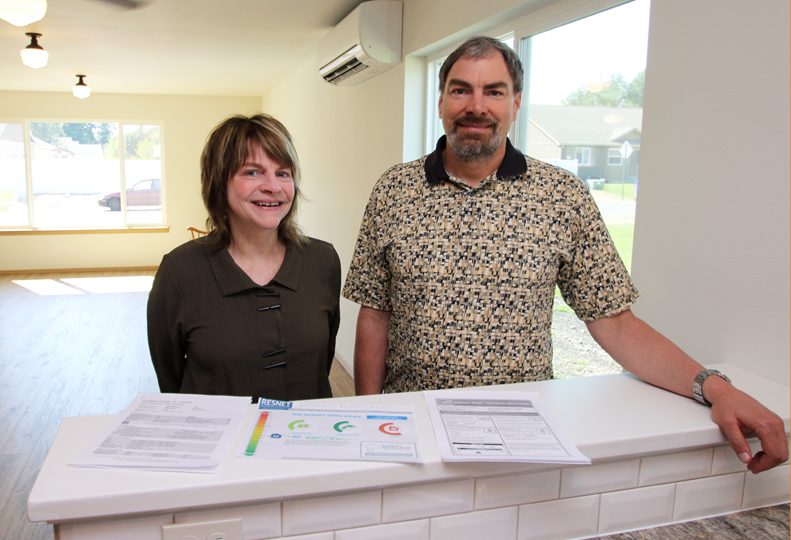
Home » Couple design, develop Energy Star rental units
Couple design, develop Energy Star rental units
Building advisers apply expertise in income property

September 14, 2017
Spokane Valley couple Jaculynn and Hans Peterson have developed a duplex that they claim is the first Energy Star, solar-ready rental income property in the city.
Construction recently was completed on the $295,000 structure, at the northwest corner of Olive Avenue and Vercler Road.
Jaculynn owns and operates Spokane Valley property management company Ceroe Group LLC. Hans is a project-management professional at Spokane-based telecommunications technology company Cerium Networks Inc.
The Petersons first started planning to become green builders in 2008.
Both are certified as sustainable building advisers through the Eugene, Ore.-based Northwest Water & Energy Education Institute.
Hans also is certified to conduct home energy audits through New York-based Building Performance Institute.
“My husband started a home energy-audit side business in 2010, and I ran a community forum online to support the green-building effort,” she says. “We decided to implement the principals and strategies we had learned about when we started building on this property.”
The duplex consists of a 1,400-square-foot unit at 12525 E. Olive, and an adjoining 1,100-square-foot unit at 513 N. Vercler Road. Each unit has two bedrooms and two baths, while the Olive unit also has a den.
The units are separated by a garage, with the only shared wall in the living space being the back of oversized closets in each unit.
Jaculynn designed the duplex using professional design software developed by Chief Architect Software, of Coeur d’Alene.
The Petersons acted as their own contractor and hired Premier Construction & Development LLC, of Post Falls, as the main subcontractor for the structure.
“It’s super insulated with a super sealed envelope,” Jaculynn says. “That’s half the battle.”
In addition to reducing heating and cooling costs compared with conventional construction, such a tight seal helps enhance indoor air quality by keeping outside air from entering the living space, she says.
Jaculynn says each unit has a ductless heating and cooling system.
“When you don’t have ducts in a house, it reduces the number of cuts going through the home, and air stays sealed within the house. There’s less dust, pollen, and pollutants,” she says.
The Energy Star certification includes a Home Energy Rating System score of 62 for the Olive unit and 63 for the Vercler unit.
On the HERS scale, the lower the score, the greater the energy efficiency. By comparison, a typical, new energy-efficient home would have a HERS score of 100, and a typical resale home has a HERS score of 130, according to the Residential Energy Services Network website.
The Energy Star certificate estimates the total annual energy cost for heating, cooling, hot water, and lights and appliances at $666 for the larger Olive unit and $621 for the Vercler unit for an estimated annual savings of $346 and $286, respectively, compared with a typical new home.
Energy Star certification requires that structures be built to meet performance standards set by the U.S. Environmental Protection Agency.
Hans says the standards are far above current building codes, and the Energy Star Program adopts stricter standards every three years.
He says he anticipates that the time is coming when metrics such as the HERS rating and energy cost estimates will have to be posted on new homes much like the window stickers displayed on new cars.
“When you go to an auto dealership, you tend to know more about the car that you’re going to buy than the house you’re going to rent or buy,” he says. “You know the fuel efficiency. You even have a tag on the window that shows you all of the components.”
Yet, he says, most people don’t have such performance metrics or specifications about their home.
Hans asserts, however, there’s more to green building than energy savings.
“You have efficiencies in energy and water, but it’s also about the complete package. It’s about comfort, maintenance costs, quality, and even health aspects.”
Jaculynn says site orientation with southern exposure is one of the most important parts of green building design.
“It’s so simple to do, and it doesn’t cost anything to just position a home correctly on the lot,” she says.
The duplex is oriented to be solar ready and is wired for future installation of solar panels, which will be installed when the cost becomes more feasible, Jaculynn says.
“The price of solar has been plummeting over the last five years,” she says. “When the day comes, all we have to do is buy the panels.”
Landscaping work still to be done will include planting native grasses and drought-tolerant plants, Jaculynn says.
Monthly rents likely will be in the range of $1,300, which will be around the market rate for similarly sized luxury rental units, she says.
“You can’t find anything like this anywhere in Spokane Valley. That’s going to dictate a slightly higher price, but are we out of the market? Absolutely not,” she says.
Latest News Up Close Real Estate & Construction Technology
Related Articles




